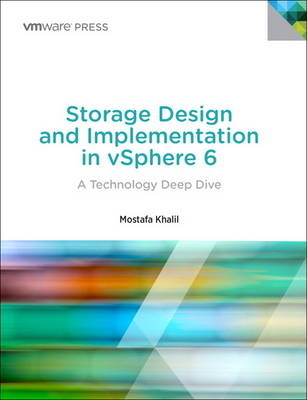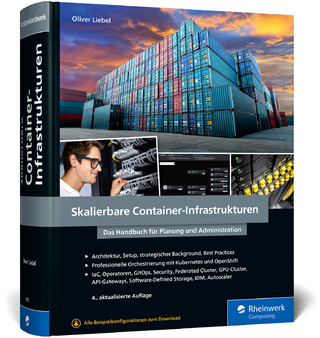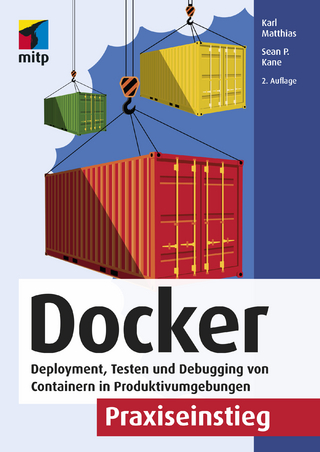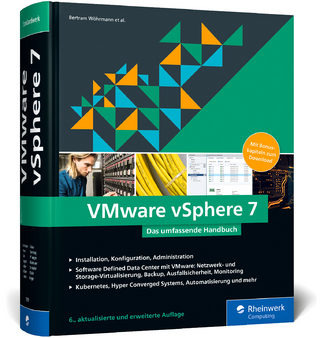
Storage Design and Implementation in vSphere 6
VMWare Press (Verlag)
978-0-13-426810-1 (ISBN)
- Titel ist leider vergriffen;
keine Neuauflage - Artikel merken
Effective VMware virtualization storage planning and management has become crucial—but it can be extremely complex. Now, VMware’s leading storage expert thoroughly demystifies the “black box” of vSphere 6 storage and provides illustrated, step-by-step procedures for performing every key task associated with it. Mostafa Khalil presents techniques based on years of personal experience helping customers troubleshoot storage in their vSphere production environments. Drawing on more experience than anyone else in the field, he combines expert guidelines, insights for better architectural design, best practices for planning and management, common configuration details, and deep dives into both vSphere and third-party storage. Storage Design and Implementation in vSphere 6, Second Edition will give you the deep understanding you need to make better upfront storage decisions, quickly solve problems if they arise, and keep them from occurring in the first place.
Coverage includes:
Planning and implementing Fibre Channel, FCoE, and iSCSI storage in vSphere virtualized environments
Implementing vSphere Pluggable Storage Architecture native multipathing, SATP, PSP, plug-ins, rules, registration, and more
Working with Active/Passive and Pseudo-Active/Active ALUA SCSI-3 storage arrays
Maximizing availability with multipathing and failover
Improving efficiency and value by unifying and centrally managing heterogeneous storage configurations
Understanding Storage Virtualization Devices (SVDs) and designing storage to take advantage of them
Implementing VMware Virtual Machine File System (VMFS) to maximize performance and resource utilization
Working with virtual disks and raw device mappings (RDMs)
Managing snapshots in VMFS and Virtual Volumes environments
Implementing and administering NFS, VAAI, Storage vMotion, VisorFS, and VASA
Integrating VSAN core and advanced features
Using Virtual Volumes to streamline storage operations and gain finer VM-level control over external storage
Mostafa Khalil is a senior staff engineer at VMware. He is a senior member of the VMware Engineering team and has worked for VMware for more than 18 years. Prior to joining VMware, he worked at Lotus/IBM. A native of Egypt, Mostafa graduated from the Al-Azhar University’s School of Medicine and practiced medicine in Cairo. He became intrigued by the mini computer system used in his medical practice and began to educate himself about computing and networking technologies. After moving to the United States, Mostafa continued to focus on computing and acquired several professional certifications, including VCDX (3, 4, 5, and 6), VCAP (4, 5, and 6)-DCD, VCAP4-DCA, VCP (2, 3, 4, 5, and 6), MCSE, Master CNE, HP ASE, IBM CSE, and Lotus CLP. As storage became a central element in the virtualization environment, Mostafa became an expert in this field. He has delivered several seminars and troubleshooting workshops at various VMware public events in the United States and elsewhere around the world.
Introduction xxxiii
Part I Storage Protocols and Block Devices
1 Storage Types 1
History of Storage 1
Birth of the Hard Disks 3
Along Comes SCSI 4
PATA and SATA–SCSI’s Distant Cousins? 4
Measuring Storage Capacity 7
Permanent Storage Media Relevant to vSphere 6 8
Summary 9
2 Fibre Channel Storage Connectivity 11
SCSI Standards and Protocols 11
SCSI-2 and SCSI-3 Standards 11
Fibre Channel Protocol 12
Decoding an EMC Symmetrix WWPN 23
Locating a Target’s WWNN and WWPN Seen by ESXi 6 Hosts 24
SAN Topology 27
Fabric Switches 31
FC Zoning 33
Designing Storage with No Single Points of Failure 37
Summary 43
3 FCoE Storage Connectivity 45
FCoE (Fibre Channel over Ethernet) 45
FCoE Initialization Protocol 47
FCoE Initiators 49
Hardware FCoE Adapters 49
Software FCoE Adapters 50
Overcoming Ethernet Limitations 51
Flow Control in FCoE 51
Protocols Required for FCoE 52
Priority-Based Flow Control 52
Enhanced Transmission Selection 52
Data Center Bridging Exchange 53
10GigE–A Large Pipeline 53
802.1p Tag 54
Hardware FCoE Adapters 55
Confi guring HW FCoE Adapters 56
Implementing SW FCoE in ESXi 6 61
Confi guring SW FCoE Network Connections 63
Enabling a Software FCoE Adapter 67
Removing or Disabling a Software FCoE Adapter 71
Using the UI to Remove a Software FCoE Adapter 71
Using the CLI to Remove a Software FCoE Adapter 72
Troubleshooting FCoE 72
ESXCLI 72
FCoE-Related Logs 75
How to Verify SW FCoE Connectivity 90
Proc Nodes Can Be Useful, Too 91
Parting Tips 93
Summary 94
4 iSCSI Storage Connectivity 95
iSCSI Protocol 95
Customizing Storage Network Confi guration 151
Troubleshooting iSCSI Connectivity 175
Summary 177
5 vSphere Pluggable Storage Architecture 179
Native Multipathing 179
Storage Array Type Plug-in (SATP) 180
Listing SATPs on an ESXi 6 Host 182
Path Selection Plug-in (PSP) 182
Listing PSPs on an ESXi 6 Host 184
Third-Party Plug-ins 184
Multipathing Plug-ins (MPPs) 185
Anatomy of PSA Components 186
I/O Flow Through PSA and NMP 187
Classifi cation of Arrays Based on How They Handle I/O 187
Paths and Path States 189
Preferred Path Setting 189
Flow of I/O Through NMP 191
Listing Multipath Details 191
Listing Paths to a LUN by Using the UI 192
Listing Paths to a LUN by Using the CLI 194
Identifying Path States and on Which Path the I/O Is Sent–FC 198
Example of Listing Paths to an iSCSI-Attached Device 198
Identifying Path States and on Which Path the I/O Is Sent–iSCSI 200
Example of Listing Paths to an FCoE-Attached Device 200
Identifying Path States and on Which Path the I/O Is Sent–FC 202
Claim Rules 203
MP Claim Rules 204
Plug-in Registration 207
SATP Claim Rules 208
Modifying PSA Plug-in Confi gurations Using the UI 213
Which PSA Confi gurations Can Be Modifi ed Using the UI? 213
Modifying PSA Plug-ins Using the CLI 215
Available CLI Tools and Their Options 215
Adding a PSA Claim Rule 217
Deleting a Claim Rule 231
Masking Paths to a Certain LUN 233
Unmasking a LUN 236
Changing PSP Assignment via the CLI 238
Summary 242
6 ALUA 243
ALUA Defi nition 244
ALUA Target Port Groups 244
Asymmetric Access State 245
ALUA Management Modes 247
ALUA Followover 248
Identifying Device ALUA Confi guration 252
Troubleshooting ALUA 259
Summary 263
7 Multipathing and Failover 265
What Is a Path? 265
Where Is the Active Path? 270
Identifying the Current Path Using the CLI 270
Identifying the I/O (Current) Path Using the UI 271
LUN Discovery and Path Enumeration 273
Sample LUN Discovery and Path Enumeration Log Entries 275
Factors Affecting Multipathing 279
Accessing Advanced Options 280
Failover Triggers 282
SCSI Sense Codes 282
Path Failover Triggers 284
Path States 288
Factors Affecting Paths States 289
Path Selection Plug-ins 298
VMW_PSP_FIXED 298
VMW_PSP_MRU 299
VMW_PSP_RR 299
When and How to Change the Default PSP 299
When Should You Change the Default PSP? 299
How to Change the Default PSP 300
PDL and APD 302
Unmounting a VMFS Volume 304
Detaching a Device Whose Datastore Was Unmounted 309
Path Ranking 313
Path Ranking for ALUA and Non-ALUA Storage 313
How Does Path Ranking Work for ALUA Arrays? 313
How Does Path Ranking Work for Non-ALUA Arrays? 315
Confi guring Ranked Paths 316
Summary 318
8 Third-Party Multipathing I/O Plug-ins 319
MPIO Implementations on vSphere 6 319
EMC PowerPath/VE 6 320
Downloading PowerPath/VE 320
PowerPath/VE Installation Overview 322
What Gets Installed? 323
Installing PowerPath/VE by Using the Local CLI 324
Verifying the PowerPath/VE Installation 326
Listing Devices Claimed by PowerPath/VE 330
Managing PowerPath/VE 331
Uninstalling PowerPath/VE 331
Hitachi Dynamic Link Manager (HDLM) 333
Obtaining Installation Files 334
Installing HDLM 335
Modifying HDLM PSP Assignments 341
Locating Certifi ed Storage on the VMware HCL 344
Dell EqualLogic PSP Routed 346
Downloading Documentation 346
Downloading the Installation File and the Setup Script 347
How Does EQL MEM Work? 347
Installing EQL MEM on vSphere 6 347
Uninstalling the Dell PSP EQL Routed MEM 351
Summary 352
9 Using Heterogeneous Storage Confi gurations 353
What Is a “Heterogeneous” Storage Environment? 353
Heterogeneous Storage Scenarios 354
ESXi 6 View of Heterogeneous Storage 355
Basic Rules of Using Heterogeneous Storage 355
Naming Conventions 356
How Does All This Fit Together? 357
Summary 363
10 Using VMDirectPath I/O 365
What Is VMDirectPath? 365
Which I/O Devices Are Supported? 366
Locating Hosts Supporting VMDirectPath I/O on the HCL 368
Confi guring VMDirectPath I/O on vSphere 6.0 369
What Gets Added to the VM’s Confi guration File? 378
Toggling an I/O Adapter as Passthrough on vSphere 6.5 378
Adding a Passthrough PCI Device to a VM by Using vSphere Web Client 380
Adding a Passthrough PCI Device to a VM by Using the HTML5 ESXi Host Client 382
Practical Examples of VM Design Scenarios Using VMDirectPath I/O 384
Hyperconverged Infrastructure 384
Passing Through Physical Tape Devices 384
Supported VMDirectPath I/O Devices 385
DirectPath I/O Example 385
Troubleshooting VMDirectPath I/O 386
Interrupt Handling and IRQ Sharing 386
Device Sharing 387
Summary 388
11 Storage Virtualization Devices (SVDs) 389
The SVD Concept 389
How Does It Work? 389
Constraints 392
SVD Design Decisions 393
Front-End Design Choices 393
Back-end Design Choices 396
LUN Presentation Considerations 397
RDM Considerations 397
Summary 400
Part II File Systems
12 VMFS Architecture 401
History of VMFS 401
VMFS3 on-Disk Layout 404
VMFS5 Layout 411
Common Causes of Partition Table Problems 418
Re-creating a Lost Partition Table for VMFS3 Datastores 418
Re-creating a Lost Partition Table for VMFS5 Datastores 423
More About VOMA 427
Re-creating the Partition Table 429
Preparing for the Worst: Recovering from a File System Corruption 432
Span or Grow? 439
Upgrading to VMFS5 449
VMFS6 455
Summary 460
13 Virtual Disks and RDMs 461
The Big Picture 461
Virtual Disks 462
Virtual Disk Types 465
Thin-on-Thin Confi guration 467
Virtual Disk Modes 468
Creating Virtual Disks Using the UI 468
Creating Virtual Disks During VM Creation 468
Creating a Virtual Disk After VM Creation 472
Creating Virtual Disks Using vmkfstools 475
Creating a Zeroed Thick Virtual Disk Using vmkfstools 476
Creating an Eager Zeroed Thick Virtual Disk Using vmkfstools 477
Creating a Thin Virtual Disk Using vmkfstools 478
Cloning Virtual Disks Using vmkfstools 480
Raw Device Mappings 484
Creating Virtual Mode RDMs Using the UI 484
Creating Physical Mode RDMs Using the UI 489
Creating RDMs Using the Command-Line Interface 490
Listing RDM Properties 491
Listing RDM Properties Using vmkfstools 494
Listing RDM Properties Using the UI 495
Virtual Storage Adapters 498
Selecting the Type of Virtual Storage Adapter 498
VMware Paravirtual SCSI Controller 500
SCSI Bus Sharing 502
Virtual Machine Snapshots 502
Creating the VM’s First Snapshot While the VM Is Powered Off 503
Creating a VM Second Snapshot While Powered On 511
Snapshot Operations 515
Reverting to a Snapshot 515
Deleting a Snapshot 518
Consolidating Snapshots 520
Reverting to the Latest Snapshot 525
Linked Clones 527
Summary 528
14 Distributed Locks 529
Basic Locking 530
Using ATS for the Heartbeat 531
What Happens When a Host Crashes? 534
Optimistic Locking 534
Dynamic Resource Allocation 535
SAN Aware Retries 535
Optimistic I/O 537
Operations That Require SCSI Reservations 537
MSCS/WSFC-Related SCSI Reservations 538
Perennial Reservations 540
Under the Hood of Distributed Locks 546
Summary 554
15 Snapshot Handling 555
What Is a Snapshot? 555
What Is a Replica? 556
What Is a Mirror? 556
VMFS Signature 557
Listing Datastores’ UUIDs via the CLI 557
Effects of Snapshots on VMFS Signatures 558
How to Handle VMFS Datastores on Snapshot LUNs 558
Resignaturing Datastores 559
Resignaturing a VMFS Datastore Using vSphere 6 Web Client 559
Resignaturing a VMFS Datastore Using ESXCLI 562
Force-Mounting 566
Force-Mounting a VMFS Snapshot Using vSphere 6 Web Client 566
Force-Mounting a VMFS Snapshot Using ESXCLI 566
Sample Script to Force-Mount All Snapshots on Hosts in a Cluster 568
Summary 572
16 NFS 573
History of NFS 573
NFS on vSphere 6 574
Confi guring an NFS Volume on NAS Servers 584
NFS Exports on EMC Unity 584
Confi guring Replication on EMC Unity 600
Creating an NFSv3 Storage VM (SVM) on a NetApp Filer 603
Creating an NFSv3 Datastore on a NetApp Filer 606
Using Kerberos Authentication with NFSv4.1 Datastores 611
ESXi Kerberos 5 Components 612
Confi guring a NetApp Filer for NFSv4.1 614
Creating an NFSv4.1 Storage VM (SVM) on a NetApp Filer by Using the CLI 614
Creating an NFSv4.1 Storage VM (SVM) on a NetApp Filer by Using the UI 616
Preparing ESXi Hosts for Kerberos Authentication 632
Confi guring ESXi Hosts for Kerberos Authentication 634
Preparing AD for NFSv4.1 Kerberos Authentication 636
Confi guring AD for UNIX Identity Management 637
Creating Kerberos-to-UNIX User Name Mapping 644
Creating an NFSv4.1 Datastore on a NetApp Filer 651
NFS Locking Mechanism 667
NFS Client Advanced Confi gurations 669
Useful Authentication-Related Commands 676
Troubleshooting NFS Connectivity 678
Summary 682
17 VAAI 683
What Is VAAI? 683
VAAI Primitives 684
Hardware Acceleration APIs 684
Thin Provisioning APIs 684
Full Copy Primitive (XCOPY) 685
Block Zeroing Primitive (WRITE _ SAME) 686
Hardware Accelerated Locking Primitive (ATS) 687
ATS Enhancements on VMFS5 687
Thin Provisioned APIs 688
NAS VAAI Primitives 689
Enabling and Disabling VAAI Primitives 690
Disabling Block Device Primitives by Using the UI 691
Disabling Block Device VAAI Primitives by Using the CLI 693
Disabling the UNMAP Primitive by Using the CLI 695
Disabling NAS VAAI Primitives 696
VAAI Filter and VAAI Plug-in 697
Locating Supported VAAI-Capable Block Devices 698
Locating Supported VAAI-Capable NAS Devices 700
Listing Registered Filter and VAAI Plug-ins 702
Listing the Confi gurations of VAAI Filters and Plug-ins 702
XCOPY Custom Options 707
Confi guring XCOPY Custom Options 708
Listing VAAI VMkernel Modules 710
Identifying VAAI Primitives Supported by a Device 711
Listing Block Device VAAI Support Status by Using the CLI 711
Listing NAS Device VAAI Support Status 714
Listing VAAI Support Status by Using the UI 714
Displaying Block Device VAAI I/O Stats Using esxtop 716
The VAAI T10 Standard Commands 719
Troubleshooting VAAI Primitives 720
Example Using the VMFS Volume Label 721
Example Using VMFS Volume UUID 721
Sample Log Entries Related to VAAI 721
Summary 723
18 Storage vMotion 725
Storage vMotion History 725
Storage vMotion Requirements 726
Storage vMotion Within the Same Host 726
Storage vMotion Between Hosts’ Local Datastores 730
How Does SvMotion Actually Work? 731
Summary 747
19 VisorFS 749
What Is VisorFS? 749
RAM Disks 752
Stateful or Stateless? 753
Boot Device Partitions 755
Rolling Back to a Previous Version 758
Summary 758
20 VASA 759
What Is VASA? 759
VASA Architecture 759
VASA Versions 760
Confi guring the vSphere Environment to Use VASA 761
Locating VASA-Certifi ed Storage Arrays on vCG 761
Installing VASA Providers 763
Registering VASA Providers 767
Summary 783
21 vSAN Core Features 785
What Is vSAN? 785
vSAN Requirements 786
The File System on the vSAN Datastore 787
vSAN Network 788
Confi guring vDS 793
Solid State Drives and Flash Storage 807
I/O Adapters 810
VMware Certifi cation Guide (vCG) 811
Looking Up vSAN Ready Nodes on the vCG 812
Ruby vSphere Console (RVC) 815
vSAN Software Components 824
Creating and Confi guring a vSAN Cluster 831
vSAN Disk Groups 839
vSAN Storage Policies 864
vSAN Storage Policy Placement Rules 870
Erasure Coding (RAID 5 and RAID 6) 888
Reconfi guring Existing Virtual Disks’ Storage Policies 897
HA on vSAN 904
vSAN Easy Installation 907
Summary 912
22 vSAN Advanced Features 913
Fault Domains 913
Creating vSAN Fault Domains 914
Listing Fault Domains via the CLI 915
Component Placement on Fault Domains 921
Stretched Clusters 924
A vSAN Stretched Cluster Inter-data Site Network 925
Calculating a vSAN Network’s Minimum Bandwidth Requirement 925
vSAN Stretched Cluster Witness 926
vSAN Stretched Cluster Witness-to-Data-Sites Network 927
Deploying a Witness Virtual Appliance 927
Customizing the Nested ESXi Witness VM Network 930
Adding a Nested ESXi Witness Node to a Datacenter 931
Verifying Witness Network Confi guration 932
Confi guring a Stretched Cluster 933
Using RVC to List Stretched Cluster Witness Information 941
vSAN Stretched Cluster I/O Path 941
vSAN Stretched Cluster Failure Modes 941
Sample UI and cmmds-tool Output from vSAN Stretched Cluster Failures 947
RAID 1 Examples 949
RAID 10 Examples 952
Comparison Between Fault Domains and Stretched Clusters 957
Nested vSAN Fault Domains 958
Nested FD Storage Policies 958
Confi guring a Nested FD Policy 959
Nested RAID 1 Confi guration 962
Nested RAID 10 Confi guration 970
Nested Fault Domain I/O Flow 975
Remote Offi ce/Branch Offi ce (ROBO) vSAN Cluster 976
Confi guring a ROBO Cluster 978
Deduplication and Compression 979
Deduplication and Compression Licensing 980
Confi guring Deduplication and Compression 980
Displaying Dedupe and Compression Stats 984
The vSAN Health Check UI 987
Confi guring Health Check 987
Accessing the Health Check UI 989
Health Check Tests 990
Running Burn-in Tests 1002
vSAN Performance Monitoring 1007
Enabling vSAN Performance Service 1007
Accessing vSAN Performance Charts in the UI 1010
Running vSAN Performance Diagnostics 1011
Displaying Cluster Back-End Performance Charts 1012
Displaying Cluster-Level VM Consumption Charts 1013
Displaying Host-Level vSAN Performance Charts 1013
Displaying VM-Level vSAN Performance Charts 1016
vSAN Observer 1016
Starting vSAN Observer for Live Monitoring 1016
Collecting an Observer Bundle 1019
Browsing vSAN Observer HTML Bundle Stats 1021
vSAN iSCSI Targets (VITs) 1022
vSAN iSCSI Targets Architecture 1022
Confi guring a VIT Network 1022
Enabling VITs 1024
Creating VITs 1025
Creating Initiator Groups 1028
VIT Confi guration Under the Hood 1030
Monitoring VIT 1038
Using ESCXLI to List VITs details 1046
Storage Policy Noncompliance 1052
Monitoring Resyncing Components via the UI 1053
Monitoring Resyncing Components via the RVC 1054
Resync Throttling 1055
Resync Throttling via the UI 1055
Resync Throttling via the CLI 1056
Sample Object Properties During Resync 1056
vSAN Sparse Format 1059
Common vSAN Basic Administrative Tasks 1062
Removing a Host from a vSAN Cluster 1062
Rejoining a Host to a vSAN Cluster 1065
Using cmmds _ tool to List Various Types 1067
Listing a Disk’s Stats by Using the CLI 1069
vSphere 6.5 vSAN Health CLI Namespace 1070
Summary 1075
23 Virtual Volumes (VVols) 1077
What Are VVols? 1077
VVols Architecture 1078
Confi guring the vSphere Environment to Use VVols 1081
Locating VASA-Certifi ed Storage Arrays on the vCG 1082
Installing VASA Providers 1083
Confi guring Block Storage Arrays for VVols 1083
Confi guring Dell Virtual Storage Manager (VSM) and Registering the VASA Provider with vCenter 1083
Allowing ESXi Hosts’ iSCSI Initiators to Access EQL VVols Protocol Endpoints 1085
Confi guring a NAS Server for VVols 1086
Creating Storage Pools for Use by EMC Unity VVols SCs 1086
Confi guring the vSphere 6 Environment for VVols 1098
Creating Virtual Machine Storage Policies for VVols 1131
Deploying New VMs Using Storage Policies 1135
I/O Flow to VVols 1142
Listing Virtual Machine Files on a VVols Datastore via the CLI 1151
OSFS and Its Role in VVols 1158
Storage Array’s View of VVols 1162
Native Snapshots on VVols 1164
Putting It All Together 1170
VVols Interoperability with Other vSphere Features 1175
VVols Replication 1177
Summary 1185
9780134268101, TOC, 6/26/2017
| Erscheinungsdatum | 28.09.2017 |
|---|---|
| Reihe/Serie | VMware Press Technology |
| Verlagsort | NJ |
| Sprache | englisch |
| Maße | 178 x 232 mm |
| Gewicht | 1960 g |
| Themenwelt | Informatik ► Betriebssysteme / Server ► Virtualisierung |
| Mathematik / Informatik ► Informatik ► Netzwerke | |
| Informatik ► Weitere Themen ► Hardware | |
| ISBN-10 | 0-13-426810-5 / 0134268105 |
| ISBN-13 | 978-0-13-426810-1 / 9780134268101 |
| Zustand | Neuware |
| Haben Sie eine Frage zum Produkt? |
aus dem Bereich


